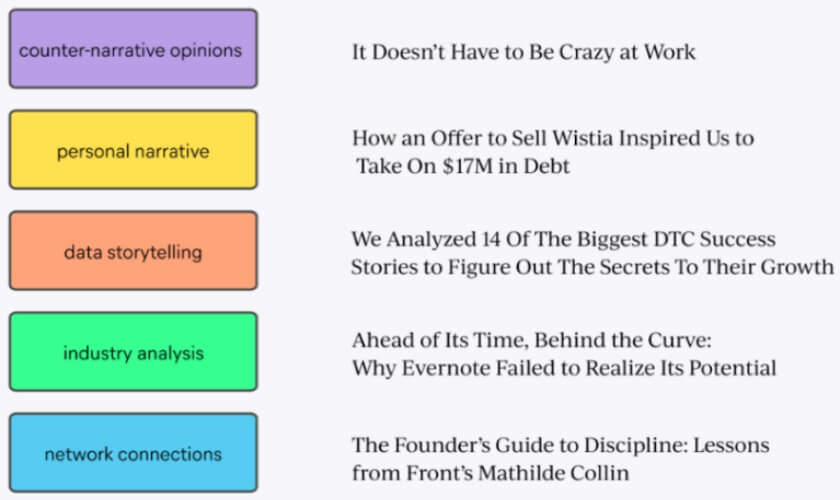Today’s buyers spend more time researching products and services than interacting with sales executives. So it comes as no surprise that 91% of B2B companies are using content marketing to inform and educate prospects about their offerings. Despite this, more than half admit that their content marketing approaches are moderately or not successful at all.
The key reason for content marketing failure is that it has a tendency to become unhelpful or less interesting for the consumer. Besides, 65% of technology buyers feel that businesses share ‘too much’ product-centric material with very little value. To break through this barrier, technology marketers need to address their customers’ most pressing needs without aggressively pushing promotional content. Create thought leadership content that provides original insights and builds credibility to achieve this.
Understanding thought leadership content
Thought leadership is built through content that offers timely and relevant subject matter expertise, insight, or training about topics that your customers care about. It can take many forms: blog posts, content contributed to other publications, infographics, whitepapers and reports, virtual events such as webinars, informative videos, magazine articles, and podcasts among others.
Today, almost every company wants to be a thought leader in its industry. So, to be highly effective and stand out, technology marketers need to focus on offering unique perspectives and in-depth knowledge that consumers can’t find anywhere else. Here’s how.
How do you establish your company as a trusted thought leader?
1. Get the buyer persona right
Having an accurate picture of your customers is imperative for effective thought leadership marketing. A nuanced understanding of the target audience with the help of buyer personas can help you move in this direction. A buyer persona is a fictitious personal description that represents your customers or desired customers. It can help you address the following questions:
- What are the key problems and challenges of your desired customers?
- What influences their decision to buy or take action?
- Where do they go for information?
Developing accurate buyer personas and establish value propositions that resonate is essential. To do so, marketers can analyze similar customer behavioral patterns. These patterns include search behavior and decision criteria, professional and personal pain points, general goals and aspirations, and demographic characteristics. Savvy marketers turn to market intelligence agencies to get an accurate picture of their customers and create buyer personas accordingly.
Through this exercise, you can gain insights into your target audience’s needs as well as the capabilities they look for in a business. Furthermore, buyer personas shouldn’t be static documents. For them to evolve as you learn more about your customers, integrate timely and relevant insights along the way. This is critical to your efforts to attract, engage, and retain high-value customers.
2. Determine where a buyer falls in the purchasing funnel
It is important to ask yourself: where are they in the buying journey before creating thought leadership content? In marketing, this is helpful for understanding the specific pain points and mindset of the customers. Focus on the following to identify the same:
- What information is your buyer looking for at each stage of the purchase funnel??
- What kind of content do they consume at each stage of the purchasing funnel?
For instance, GE has found a remarkable way to incorporate thought leadership that engages customers effectively. One of the world’s foremost technology companies has gone the extra mile to build Txchnologist – a microsite that’s intelligent, addictive, and imbued with its brand knowledge. Its dynamic interface provides readers with unique and informative content in a captivating manner. Furthermore, this helps GE to present itself as an authoritative voice in the field of innovation.
Here’s how you can approach your buyer persona at each stage of the purchase funnel:
Awareness
Know your audience inside and out. Depending on whether your content is aimed at a decision-maker, technical executive, or business leader, you’ll have to create different thought leadership pieces.
Interest
Learn what problems your buyer is trying to solve. This will help you decide on the content tone. It can range from counter-narrative opinions, personal narratives, and data storytelling to industry analysis and network connections. Here’s an example:

Source: Carney
Desire
During this stage, the potential buyer has already accepted the value proposition. They are just one step from deciding to purchase. You can stand out by making an emotional connection with the consumer to make them ‘want’ your product or service. Instead of selling, focus on proposing a solution to their problem. Make the takeaways crystal-clear with an evidence-backed approach.
Action
This is where you can provide the buyer with a call-to-action (CTA). To do so, provide them with links to download whitepapers, reports, and case studies that help them learn more about your proven authority in the industry. Inspire them enough to want to engage with you more.
3. Creating effective multi-channel thought leadership content
Businesses that create thought leadership content enjoy greater reputation, greater influence, and more effective sales than those that do not. For example, IBM’s think tank, Institute for Business Value, creates innovative thought leadership by providing insights for business leaders to stay current on industry trends. Major business consultants and experts bring research and insight to market across a wide range of topics and formats. Moreover, the content stands out from the competitors because of its credibility.
To be an effective thought leader, you need to focus on establishing yourself as a reliable resource on multiple channels. However, with so many channels available today – websites, social media, video platforms, podcasts, and webinars – a clear and consistent thought leadership strategy is a challenge for marketers. Here are two effective ways to propagate your company’s messaging on different channels:
Build strong foundations with original content
Start by publishing in-depth, long-form content on your website. In addition to highlighting benefits over features, marketing communications should be data-driven and be backed by meaningful insights.
Repackage and repurpose
You can repurpose your original content in several ways to reach your target audience once it has been created. For example, you can discuss the findings from your latest research report or article on a podcast or webinar. You can also use it to develop an infographic. Additionally, a whitepaper can also serve as a basis for social media posts or blogs with in-depth analysis. The format of your thought leadership content will change with the type of platform you choose to engage with the audience.
It takes time to establish thought leadership. Though most subject matter experts have insightful ideas to share, they lack the time and focus to create thought leadership content consistently. The world is changing rapidly, and your audience wants to know that you understand their industry, market, company, and business environment. As a leader in data and insights, we partner with technology companies in order to accomplish this.
Based on our proprietary research, our marketing and content solutions allow you to engage customers consistently and drive better content marketing results. Contact us to know more.






